As a new parent, buying a child seat seems baffling, startlingly expensive and highly theoretical, like buying a helmet when you don't even have a motorcycle.
Then, your incredibly precious, tear-jerkingly wonderful, heart-string-playing maestro of a bundle of joy arrives and you have to put little him or tiny her into said child seat, and suddenly it becomes the most important, and borderline frightening, purchase you've made.
All you want, of course, is for your baby seat to be safe, to keep that perfect little person sheltered from any harm, so it would, of course, horrify you to learn that hardly any of the car seats on sale, despite meeting Australian Safety Standards, are as safe as they should, or could be.
And you'll be even more terrified, and appalled, to learn that you're probably making it even less safe, by failing to install or use it correctly. One study found that at least 90 per cent of parents used or fitted their child seats incorrectly, so there's a good chance you either are one of them, or, hopefully, you used to be, and got wise.
If all this is bring you out in a light sweat of panic, you should definitely read on.
Almost every child seat fails crash test
Only one of 22 children's car seats recently tested by the NSW Crashlab provided its occupant with the maximum five-star protection against traumatic injuries to the head, neck and torso in a simulated head-on collision at a speed less than 60km/h.
Read that sentence again, because it's deeply worrying. Obviously your first question is, 'is that the one I bought?' and if you do own a $447 Nuna Klik (rear-facing) child seat, you're in luck, because it was the only one that scored five stars for the protection it provided in frontal, side and oblique crash tests at speeds ranging from 32km/h up to 56km/h.
Yes, 56km/h is a very high-speed impact - in most situations, hitting the brakes will reduce your impact speed significantly - with the crash applying the same amount of energy to the tested child-size test dummy as would be experienced by falling from a five-storey building. But that's the kind of impact these seats are supposed to be able to endure.
Even more alarmingly, only four of the 22 seats tested managed to score even four stars for protection. And, worryingly, if you look at the table below, paying the highest price doesn't always guarantee you the best protection, so you can't even go on that. Or not always.
Just buying the best, and safest, seat you can find of your child is not the end of the battle.
The seats were being tested under a new, more accurate, and obviously tougher star-rating system, designed to measure by how much the seats exceed the minimum national safety standard (which does make you wonder if that standard is high enough).
Six of the seats tested scored only one star, and if you've bought any of these it might be time for a deep sigh - the $399 Maxi-Cosi Luna forward-facing seat, the Infa-Secure Kompressor 4 rear-facing child seat, and the $169 Babylove Cosmic II forward-facing seat.
NSW Roads Minister Melinda Pavey reacted to the results, saying there was a "vast difference in the quality of protection provided", and it was important for consumers to know how child seats rated when put to the test.
The Minister pointed out that every seat on the market meets Australia's high standards: "If they were unsafe, we would call it out, but some prove to be better than others."
In other words, they're all very good, in theory, it's just that some are much more good than others.
Fit for purpose
Just buying the best, and safest, seat you can find of your child is not the end of the battle, because if you don't install it properly, it simply won't work. And they can be confusing.
Someone who looks a lot like the author of this story drove his newborn all the way from Sydney to Canberra to show him off to his friends some years ago, only to have it pointed out by a more experienced parent that he'd put the seat in backwards.
This was a Man Fail of horrific proportions, and his wife may have let him know it in no uncertain terms.
This unfortunate idiot was far from alone in making such a mistake, sadly. A study by Neuroscience Research Australia, which watched as parents read manuals and then attempted install and then properly fit a child-sized mannequin into a rear-facing restraint found that at least 90 per cent of parents made mistakes.
Previous research, conducted by the RACV, has found that up to 70 per cent of child seats being used on a daily basis are incorrectly fitted, which is a staggering figure. If that many people were driving around with their seatbelts on the wrong way, something would surely be done.
What does not make life easy for parents is the complexity of the modern child seat, and the almost Ikea-like impenetrability of some instruction manuals.
Sure enough, not one of the 22 seats tested by the NSW Centre for Road Safety, as part of its annual Child Restraint Evaluation Program, scored five stars when it came to being rated for "ease of use". Not one.
The obvious advice here is to get your car and your seat down to an authorised child-restraint fitting station.
The Crashlab experts evaluated the instructions and assessed whether the seats were easy to secure and release.
Most of the seats tested scored a lowly two stars in this category, and only one, the Safe-N-Sound kid guard pro booster seat - for children up to 10 years of age - got four stars for ease of use (it also got four stars for protection, making it one to put on your shopping list).
Roads Minister Pavey acknowledged that a big challenge for parents was ensuring the restraint was installed properly.
"You might have the best restraint there is, but if it is not put in properly it is not going to provide protection the child needs," she said.
The obvious advice here is to get your car and your seat down to an authorised child-restraint fitting station in your State or Territory, and to do so before baby arrives.
One body that provides assistance with installation is the NRMA, where road-safety expert Dimitra Vlahomitros said the release of the disappointing new ratings should encourage manufacturers to work on raising the safety and ease of use of their products to five stars.
Faced with a choice
It would come as no surprise to anyone from Sweden that the best-performing child seat in the Crashlab tests was a rear-facing unit, because that country believes all children should be sitting facing backwards, right up to the age of seven or eight.
Swedish car seats allow children to sit rear facing up to a weight of 25kg, which is around the average for an eight-year-old, and before you gasp at the idea of not being able to see your children in the rear-view mirror, the Swedes would like to point out that it's actually easier, and safer, for a driver to communicate with a child whose head is so much closer to yours.
Not long after my first child arrived, a Volvo safety expert implored me to get a rear-facing seat, and keep my son in in until he was at least in primary school (I must admit, I didn't listen). We don't tend to do it past 12 months of age, of course. The national recommendation in Sweden is to keep them rear facing until age four.
The advantage of rear-facing is the superior protection of a child's head, neck and spine in any frontal collision.
Swedish children have been sitting rear facing since the mid 1960s, when a Swedish professor, Beril Aldman, came up with the idea after watching a TV program about the astronauts in the Gemini space capsule, and noting that they were laying on their backs, in the opposite direction from acceleration.
The advantage of rear-facing is the superior protection of a child's head, neck and spine in any frontal collision, because the impact pushes them further into the seat, where they are better protected.
Children have weak bones and neck muscles, which are better protected while rear facing. In a front-end collision, the whole of the child's back takes the strain of the impact, not its much more vulnerable neck.
So what are their figures like? Well, from 1992 to June 1997, only nine children who'd been properly restrained in rear-facing seats died in motor vehicle crashes in Sweden - where there are more then a million rear-facing seats in use - and all of those involved catastrophic crashes with "severe intrusion" and few adult survivors.
Swedish research has shown that rear-facing children's car seats reduce serious injuries by 92 per cent, while the forward-facing seats only reduce injury by 60 per cent.
In 1996, 59 children under 16 died on NSW roads alone. In the past few years, that number has dropped to fewer than 20 a year.
It does make you wonder whether the Swedes might be on to something. They sure do love safety.
| Model name | Mode | Protection rating | Ease of use rating | RRP |
| Nuna Klik | Rear facing | 5 stars | No stars | $447 |
| Safe-N-Sound Kid Guard Pro | Booster seat up to 10 years | 4 stars | 4 stars | $309 |
| Safety 1st Summit AP ISOFIX | Rear facing | 4 stars | 2 stars | $327 |
| Infa-Secure Luxi II | Booster seat | 4 stars | 2 stars | $279 |
| Babylove Taurus 2 | Forward facing | 4 stars | 2 stars | $149 |
| Infa-Secure Versatile | Booster seat | 3 stars | 3 stars | $69.95 |
| Hipod Kansas | Rear facing up to 2.5 years | 3 stars | 2 stars | $119 |
| Babylove Taurus 2 | Booster seat | 2 stars | 3 stars | $149 |
| Safe-N-Sound Novus | Booster seat | 2 stars | 3 stars | $229 |
| Infa-Secure Kompressor 4 Treo | Forward facing | 2 stars | 2 stars | $408.90 |
| Babylove Cosmic II | Rear facing | 2 stars | 2 stars | $159 |
| Safe-N-Sound Novus | Forward facing | 2 stars | 2 stars | $229 |
| Hipod Kansas | Forward facing | 2 stars | 2 stars | $119 |
| Infa-Secure Grandeur Treo | Rear facing up to 2.5 years | 2 stars | 2 stars | $539 |
| Safety 1st Summit AP ISOFIX | Forward facing | 2 stars | 1 star | $327 |
| Infa-Secure Luxi II | Rear facing | 2 stars | 1 star | $279 |
| Maxi-Cosi Citi | Rear facing | 1 star | 2 stars | $379 |
| Infa-Secure Kompressor 4 Treo | Rear facing up to 2.5 years | 1 star | 2 stars | $249 |
| Babylove Cosmic II | Forward facing | 1 star | 2 stars | $169 |
| Infa-Secure Grandeur Treo | Forward facing up to 8 years | 1 star | 2 stars | $479 |
| Maxi-Cosi Luna | Forward facing up to 8 years | 1 star | 2 stars | $399 |
| Infa-Secure Luxi II | Forward facing | 1 star | 1 star | $369 |








.jpg)